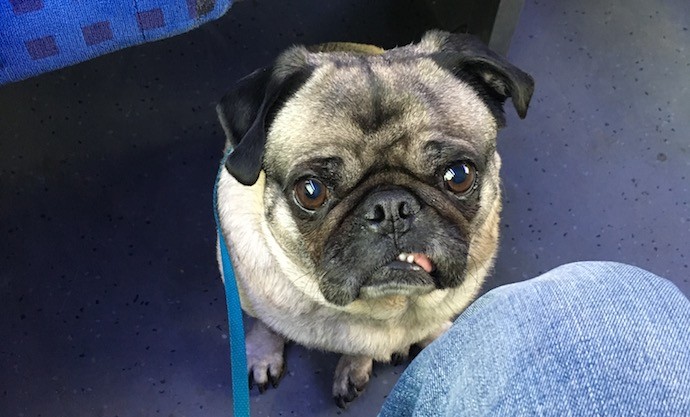This is a guest post by Stephanie Yoder, a girl who can’t sit still! She writes about everything related to Millennial travel at Why Wait to See the World? (formerly Twenty-Something Travel).

Owning a dog is just the best: long walks and cuddles on the couch from an eternally loyal best friend. The only huge drawback is that it makes it much harder to travel. Unlike a cat, you can’t just leave your dog alone with a bucket of food, a litter box and then hope for the best. You’ll need to leave him the care of a dog-sitter or at an expensive kennel. It can really cut into your travel budget.
Unless… you take your dog with you. It’s not the easiest, and not the most enjoyable for some dogs, but it is worth it when traveling with your dog is the best or the only option. Last year we took our funny little terrier Leo across the country and back again. It wasn’t a difficult process, but here is what you need to know.
Know the Rules
Every airline has slightly different rules for traveling with pets in the cabin. Some don’t allow it at all, and those that do generally have weight and breed restrictions. Unlike babies, dogs don’t fly for free. There is usually a fee per flight that can range from $30-$500.

Usually the cap is about 9 kilograms (20 pounds) – although in my experience there is a little wiggle room as they don’t usually weigh your dog at check in. Larger dogs will have to fly in kennels under the plane. Some airlines also have restrictions against brachycephalic (flat faced) breeds of dogs, which are more prone to respiratory issues while flying. Breeds like pugs, Boston terriers and bull dogs might run afoul of these rules.
Aside from that, your dog’s presence on the flight is subject to availability. Most airlines only allow a handful of in-cabin animals on a single flight. Makes sure you call and check that there is space available on the flight, and that you reserve both of your travel at the same time. Call again 24 hours before your flight to remind them you are traveling with a dog.
Talk to Your Vet
Most airlines will require a health certificate from your veterinarian issued within 7 days of departure (you don’t need a second certificate for your journey home even if it is outside that time frame). You might need immunization records if you are traveling internationally.
In my experience, airline personnel usually don’t ask to see these records but you will want to have them just in case. If you don’t produce them, you’re dog could be barred from the flight.

While you’re at the vet, take some time to talk about the best method for keeping your dog calm during the flight. Some people choose to sedate their pets with low doses of Xanax, but you may want to do a test run first since it can hype some dogs up. Your vet may have some other ideas on non-medical ways to keep your pet calm depending on their health and temperament.
We chose not to medicate our dog, and tried some essential oils to calm him. The oils did nothing, so we kept him calm but talking to him during the flight, feeding him treats and stroking his head.
Prep Your Pooch
Traveling on a plane can be a pretty scary experience for a dog. It’s loud, and confusing, and smells kind of weird. You will want to do everything you can to make them as comfortable as possible.

Get your dog a comfy soft crate (make sure it fits airline restrictions for fitting under the seat). It should be big enough for them to turn around comfortably and the sides should be ventilated. Give your dog the chance to get used to the carrier, have them spend some time in there each day and reward them with treats. It’s a good idea to have them hang out in there while in motion as well- take a car ride with them.
Before our flight we spent weeks practicing with Leo. He would sit in the crate and we would shower him with treats and praise until he started to actually enjoy that space. We laid down extra padding and put a couple of his favorite toys in there. We also lined the bottom with absorbent puppy pads in case he had an accident in transit (which he never did).
On the Day
On the day you are flying, feed your dog 4 hours before departure, so that they have enough time to digest and pass their food. Give them lots of water to drink so they don’t get dehydrated during the flight. Take them for a very long walk if you have time, to work off some energy.
Check in early for your flight. Most airports have some sort of designated pet area where your pooch can relieve themselves before the big flight. Once you’re up in the air, do your best to help your pet stay calm. They will probably need to stay in their crate under the seat for the whole flight but you can reach down and talk to and comfort them.
When you’ve arrived at your destination and de-boarded you can finally let your friend go free. Take them outside for some fresh air and breathe a sigh of relief – you made it!
Thank you very much Stephanie for this guest post! Stephanie writes about travel for millennials on her website, Why Wait To See The World. You can also follow Why Wait To See The World on Facebook, Twitter @whywaitworld, and Instagram.












